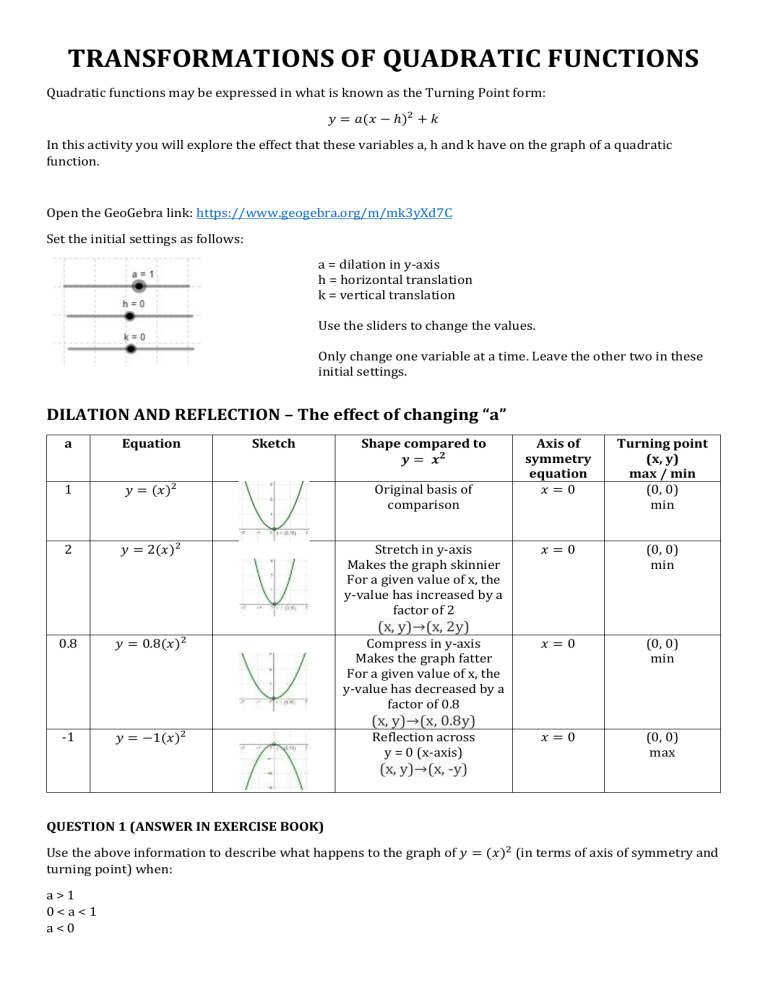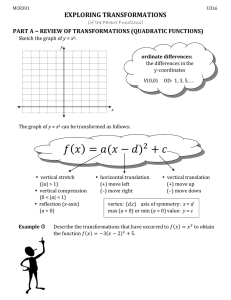
TRANSFORMATIONS OF QUADRATIC FUNCTIONS Quadratic functions may be expressed in what is known as the Turning Point form: 𝑦 = 𝑎(𝑥 − ℎ)2 + 𝑘 In this activity you will explore the effect that these variables a, h and k have on the graph of a quadratic function. Open the GeoGebra link: https://www.geogebra.org/m/mk3yXd7C Set the initial settings as follows: a = dilation in y-axis h = horizontal translation k = vertical translation Use the sliders to change the values. Only change one variable at a time. Leave the other two in these initial settings. DILATION AND REFLECTION – The effect of changing “a” a Equation Sketch Shape compared to 𝒚 = 𝒙𝟐 Axis of symmetry equation 𝑥=0 Turning point (x, y) max / min (0, 0) min 1 𝑦 = (𝑥)2 Original basis of comparison 2 𝑦 = 2(𝑥)2 Stretch in y-axis Makes the graph skinnier For a given value of x, the y-value has increased by a factor of 2 𝑥=0 (0, 0) min Compress in y-axis Makes the graph fatter For a given value of x, the y-value has decreased by a factor of 0.8 𝑥=0 (0, 0) min Reflection across y = 0 (x-axis) 𝑥=0 (0, 0) max (x, y)→(x, 2y) 0.8 2 𝑦 = 0.8(𝑥) (x, y)→(x, 0.8y) -1 2 𝑦 = −1(𝑥) (x, y)→(x, -y) QUESTION 1 (ANSWER IN EXERCISE BOOK) Use the above information to describe what happens to the graph of 𝑦 = (𝑥)2 (in terms of axis of symmetry and turning point) when: a>1 0<a<1 a<0 TRANSLATION – The effect of changing “k” k Equation Sketch Shape compared to 𝒚 = 𝒙𝟐 0 𝑦 = (𝑥)2 Original basis of comparison 1 𝑦 = (𝑥)2 + 1 Vertical translation, 1 unit up the y-axis For a given value of x, the yvalue has increase by 1 unit Axis of symmetry equation 𝑥=0 Turning point (x, y) max / min (0, 0) min 𝑥=0 (0, 1) min 𝑥=0 (0, 3) min (x, y)→(x, y+1) 3 𝑦 = (𝑥)2 + 3 Vertical translation, 1 unit up the y-axis For a given value of x, the yvalue has increase by 3 units (x, y)→(x, y+3) -1 𝑦 = (𝑥)2 − 1 Vertical translation, 1 unit down the y-axis For a given value of x, the yvalue has decrease by 1 unit 𝑥=0 (0, -1) min -2 𝑦 = (𝑥)2 − 2 Vertical translation, 2 units down the y-axis For a given value of x, the yvalue has decrease by 2 units 𝑥=0 (0, -2) min (x, y)→(x, y-1) (x, y)→(x, y-2) QUESTION 2 (ANSWER IN EXERCISE BOOK) Use the above information to describe what happens to the graph of 𝑦 = (𝑥)2 (in terms of axis of symmetry and turning point) when: k>0 k<0 TRANSLATION – The effect of changing “h” h Equation Sketch Shape compared to 𝒚 = 𝒙𝟐 Axis of symmetry equation 𝑥=0 Turning point (x, y) max / min (0, 0) min 0 𝑦 = (𝑥)2 Original basis of comparison 1 𝑦 = (𝑥 − 1)2 Horizontal translation, 1 unit to the right in the xaxis 𝑥=1 (1, 0) min (x, y)→(x+1, y) 3 𝑦 = (𝑥 − 3)2 + 3 Horizontal translation, 3 units to the right in the xaxis 𝑥=3 (3, 0) min -1 𝑦 = (𝑥 + 1)2 − 1 Horizontal translation, 1 unit left in the x-axis 𝑥 = −1 (-1, 0) min Horizontal translation, 2 units left in the x-axis 𝑥 = −2 (-2, 0) min (x, y)→(x+3, y) (x, y)→(x-1, y) -2 𝑦 = (𝑥 + 2)2 − 2 (x, y)→(x-2, y) QUESTION 3 (ANSWER IN EXERCISE BOOK) Use the above information to describe what happens to the graph of 𝑦 = (𝑥)2 (in terms of axis of symmetry and turning point) when: h>0 h<0 SUMMARY The transformations of a quadratic are easily seen when it is expressed in turning point form 𝑦 = 𝑎(𝑥 − ℎ)2 + 𝑘 Where: a = dilation in y-axis h = horizontal translation k = vertical translation Key features of a graph include: The coordinate of the turning point, (h, k) and whether it is a maximum or a minimum The y-intercept (0, y) – a quadratic will only have one y-intercept The x-intercepts (x, 0) – a quadratic may have 0, 1, or 2 x-intercepts. Axis of symmetry PRACTICE Use the GeoGebra to complete the following table. When copying the graph into the grid, use a screen shot and then adjust the picture size in the PICTURE TOOLS > FORMAT tab to be 2.9 cm wide. Don’t worry about the height, just set the width and the height will automatically adjust. >> Equation 𝑦 = 0.5(𝑥 − 3)2 − 2 𝑦 = −2(𝑥 + 1.5)2 + 1.2 𝑦 = −𝑥 2 + 3 𝑦= 1 2 𝑥 +2 2 Sketch a h k 2 -1 1.5 -0.3 0 4 -1 -4 0 Axis of symmetry equation Turning Point (x, y) max/min x-int (when y = 0) y-int (when x = 0)

